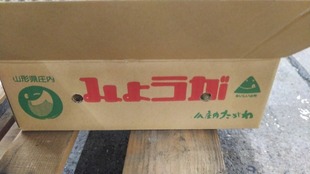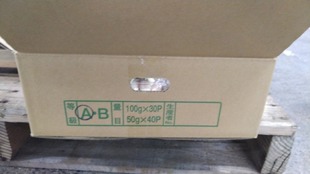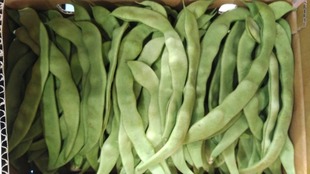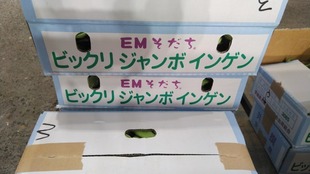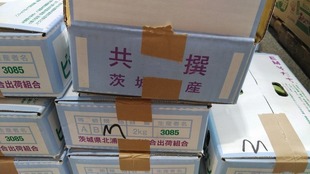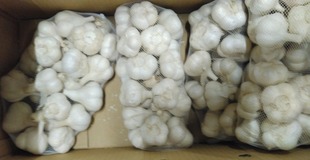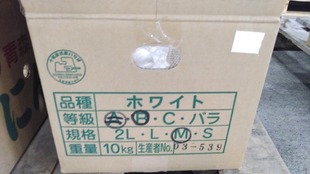From Towada Chamber of Commerce and Industry: The Towada Chamber of Commerce and Industry has entered into an agreement with the Towada Barayaki Seminar, a civic group that works to revitalize the town through food, for the exclusive use of the trademark Towada Belly Meat Yaki, and manages the use of the trademark and the brand. A dish made of beef belly and a large amount of onions, seasoned with a sweet and spicy soy sauce, and then grilled on a griddle. There are also grilled pork belly and horse belly. It is said to have originated at a food stall in front of the Misawa US military base about 50 years ago, and it spread to Towada City, which is in the same cultural area, and is now loved by the citizens of Towada and has become a soul food.
Towada City, Misawa City, Kamikita District, Sannohe District, Aomori Prefecture (Towada Katsuai Ichiba; Towada Seika Co., Ltd.)
The oldest encyclopedia in Japan, “Wamyō Ruijushō,” compiled in the middle of the Heian period, has the description “蒜; ail.” It was in the early Muromachi period that it came to be called “Garlic”. It is said that the etymology is “忍辱; forbearance (in the face of difficulty, persecution, etc.)” in Buddhism, which hates odors. From pure white and beautiful garlic on the epidermis.(Because it is a fruit of pure white color like snow that accumulates in Fukuchi Village, Sannohe District, Aomori Prefecture (Currently Fukuchi Area(It was an inland village adjacent to the western part of Hachinohe City, but disappeared because it merged with Nagawa Town and Nanbu Town on January 1, 2006 and became a new Nanbu Town.), Nanbu Town, Sannohe District) of origin-Famous as Fukuchi White Six Pieces.)
December 2021, Prefectural Sanbongi Agricultural High School in Towada City, Aomori Prefecture (Ministry of Education, Culture, Sports, Science and Technology designated agricultural manager training high school: Only one general education. Focusing on activities that make use of learning, such as learning, finding and solving local problems, we are aiming for a one-of-a-kind general course that is not found in other schools. In addition to raising animals, we have created an environment where you can learn a wide range of things such as the environment that supports production, civil engineering, processing and distribution of agricultural products, and we are continuing to promote education aimed at professionals in each field. Through various events and club activities, the students' own hands Foster a wealth of human resources to achieve one thing while collaborating with colleagues. Large-scale farms, dormitory education, agricultural clubs will continue to be enhanced, and general departments will also participate as needed. We are promoting education that maximizes the merits of agricultural high schools.) In Aomori Prefecture, a boy student who was practicing cattle breeding was found to have collapsed unconsciously in the barn. Seems to have decided to set up an accident investigation committee to verify the guidance situation at the school. This was revealed at a press conference by the Aomori Prefectural Board of Education on June 20, 2022. In December 2021, a 17-year-old boy who was practicing agriculture in the barn of Towada Prefectural Sanbongi Agricultural High School was found with blood bleeding from his head and was taken to the hospital, but he is still conscious. It is the contents. On June 28, the prefectural board of education set up an accident investigation committee consisting of six people, including lawyers and academic experts, saying that it was necessary to confirm that the faculty members and schools who were instructing at that time had not made any mistakes regarding this accident. It has been clarified that the first meeting will be held. It seems that the committee will proceed with the verification based on the accident reports submitted by the school so far. Towada Fruit and Vegetables Co., Ltd. is composed of 2 cities and 8 towns, including Misawa City, Kamikita District, and Sannohe District (partly), centering on Towada City, and occupies almost the upper 13 areas in the south of the prefecture. “Towada City”, A beautiful town where rich nature and art are fused, such as Lake Towada, Oirase Gorge, and Hakkoda, which are woven by the four seasons and emotions, and the government office street, which is centered around the Towada Art Center. By making the most of the diverse local resources that we have carefully inherited from our predecessors and the wisdom of the citizens living in this town, and working together, more people will “want to live” and “continue to live.” We will promote community development that is strongly supported by want and want to visit, and create an ideal hometown full of hope for the future that can be passed on to children who will lead the next generation with strong pride and confidence. I will continue. It is located in the center of the southern part of the prefecture and has an area of 688.60 km2 due to the merger. The population is gradually increasing from the latter half of the Showa era to the Heisei era, and it seems that the local environment is comfortable to live in. However, it decreased temporarily in 1990 and 1999. However, it seems that there is an increasing trend now. It is formed from areas with abundant natural environments such as Mt. Hakkoda and Lake Towada, and areas with rural and urban functions, which are deeply rooted in the areas I introduced earlier. There are Hachinohe City and Misawa City within a 20 km radius of the city, and Hachinohe City in particular is a major rival city for expanding the commercial area of Towada City. I also heard that in recent years, the suburbs of Shimoda Town have had a great influence on maintaining Towada's trade area since inviting a large shopping center. From here, I heard from my relatives, but there are concerns about local residents and local business and industry associations. As in many local cities in recent years, it seems that the central city area is becoming donuts and sprawl against the backdrop of population outflow to suburbs, declining birthrate and aging population due to the progress of motorization and lifestyle changes. Moreover, in recent years, due to the diversification of consumer needs and the widening of the range of purchasing trends due to the development of the automobile society, the outflow of customers to large stores in the suburbs of the city and large shopping centers in the Shimoda Town and Hachinohe city areas Both the trade area population and the absorption rate population have shown a significant decrease or decline. As a result, the number of retail and commercial stores in the central block has decreased, the number of vacant stores and vacant lots has increased, the retail commercial activities and attractiveness of the central city as the face of the city have declined significantly, and the decline of the central city has been accelerating. Local residents and the government are worried about such changes in the situation, and based on the Central City Invigoration Law, formulated the “Towada City Central City Invigoration Basic Plan” in August 2020. In this basic plan, based on the results of the workshops of citizens and merchants, the direction of future town development and specific items to be examined are summarized. For more information, please contact the website, government office, or parliamentary secretariat for an easy-to-understand explanation. The city was pioneered in 1859 by Tsuto NITOBE(Famous as the grandfather of Inazo NITOBE, the portrait of the previous 5000-yen bill. At the start of the business, old man was already 62 years old, and it was a challenge after the average life expectancy at that time was far beyond his 50s. At that time, farmers suffered from repeated bad harvests and famines, and migrant workers and escapes continued. Therefore, in order to stabilize rice production and save the lives of farmers, old man planned to draw water from the Oirase River and develop a 2,500 ha paddy field on the barren Sanbongihara Plateau. In addition to the investment from the clan, many investors were solicited for the funds, and the private property of the den was also used. After the introduction of advanced civil engineering technology and the labor of many farmers, after difficult construction such as tunnel construction through hard rock, it took about four years to successfully draw water into the barren wilderness. The completion of this waterway brought rice harvests to the area for the first time in the fall of 1860, and when the lord of the Morioka domain, Toshihisa, visited the waterway, the waterway was named Inaoi River. After that, the reclamation project was handed down to the local people, the waterway reached the Pacific coast, and the total length including the tributaries was 70 km. Today, it moisturizes about 5,900 ha of paddy fields and is popular with local citizens as a waterside for relaxation. In the city, there is the Nitobe Memorial Museum(BUSHIDO - 東三番町), a museum facility whose predecessor is the Nitobe Bunko, a privately-owned company founded by Inazo NITOBE, who is famous as an international representative of Japan.) and others. Located in the central part of the green Sanbongihara plateau(It used to be a wilderness called “Sanbongi” because there are only three trees.)at the foot of magnificent mountain Hakkoda in the southeastern part of the prefecture, it is known as the eastern entrance of the national park “Lake Towada”. In addition, the southern region has produced many famous horses since the Heian and Kamakura periods, and the city has been busy with horse auctions since the horse market was held in 1863 during the feudal era. Later, the War Horse Replenishment Department was also established, and it was widely known as a horse-producing area. 国指定文化財 : 重要文化財(建造物), 旧笠石家住宅, 昭和48年2月23日, 大字奥瀬字栃久保, 特別名勝及び天然記念物 : 十和田湖および奥入瀬渓流, 昭和27年3月29日, 十和田市, 秋田県小坂町, 天然記念物 : 法量のイチョウ, 大正15年10月20日, 大字法量字, 銀杏木, 国登録有形文化財 : 建造物, カトリック十和田教会, 平成27年8月4日, 稲生町, 県指定文化財 : 無形民俗文化財, 南部切田神楽(南部切田神楽会), 昭和31年5月14日, 大字切田, 国の記録作成等の措置を講ずべき無形の民俗文化財, 平成16年2月6日(選択), 無形民俗文化財南部駒踊(洞内南部駒踊保存会), 昭和34年10月6日, 大字洞内, 国の記録作成等の措置を講ずべき無形の民俗文化財, 昭和49年12月4日(選択), 史跡 : 一里塚(一対二基), 昭和36年10月6日, 大字伝法寺字平窪, 史跡 : 一里塚(一対二基), 昭和36年10月6日, 大字大沢田字池ノ平, 天然記念物 : モミの木, 昭和47年12月6日, 大字沢田字水尻山, 市指定文化財 : 有形文化財, 彫刻, 法心和尚像, 昭和40年3月30日, 大字洞内字前田, 彫刻 : 道無和尚像, 昭和40年3月30日, 大字洞内字前田, 彫刻 : 伽羅聖観世音菩薩像, 昭和40年3月30日, 大字洞内字前田, 史跡 : 法心塚, 昭和40年3月30日, 大字洞内字沼田野古文書新山神社の記録及び修験道の古記録類, 昭和43年4月3日, 大字赤沼字下平, 史跡 : 一里塚, 昭和55年1月31日, 大字相坂字白上, 古文書 : 新渡戸記念館収蔵品及び新渡戸家文書, 昭和56年4月24日, 東三番町, 史跡 : 板石塔婆, 平成2年8月23日, 大字大不動字, 柏木古文書六十六部日本廻国巡礼納経札, 平成2年8月23日, 大字伝法寺字平窪, 史跡 : 山神の石碑, 平成2年8月23日, 大字三本木字倉出, 史跡 : 金毘羅山の石碑, 平成2年8月23日, 大字三本木字倉出絵図寛文三本木村絵図, 平成10年6月19日, 元町西一丁目, 歴史資料 : 三本木原実測図, 平成11年8月23日, 東二十一番町, 史跡 : 日本廻国納経供養塔, 平成26年11月28日, 大字深持, 古文書 : 廻国奉納経帳, 平成26年11月28日, 大字奥瀬, 無形文化財 : 民俗芸能, 南部駒踊(南部駒踊米田保存会), 昭和40年10月8日, 大字米田, 民俗芸能 : 南部駒踊(南部駒踊滝沢保存会), 昭和40年10月8日, 大字滝沢, 民俗芸能 : 南部駒踊(南部駒踊立崎保存会), 昭和40年10月8日, 大字立崎, 民俗芸能 : 藤島獅子舞(藤島獅子舞保存会), 昭和46年12月13日, 大字藤島, 民俗芸能 : 南部駒踊(南部駒踊相坂若駒会), 昭和46年12月13日, 大字相坂, 民俗芸能 : 南部洞内神楽(洞内南部神楽保存会), 昭和55年1月31日, 大字洞内, 民俗芸能 : 沢田鶏舞(沢田鶏舞保存会), 平成5年7月5日, 大字沢田, 民俗芸能 : 三日市神楽(三日市神楽保存会), 平成5年7月5日, 大字沢田, 民俗芸能 : 六日町鶏舞(六日町鶏舞保存会), 平成7年3月22日, 大字相坂, 民俗芸能 : 南部駒踊(南部駒踊上舘保存会), 平成7年3月22日, 大字切田, 民俗芸能 : 晴山獅子舞(晴山獅子舞保存会), 平成16年10月19日, 大字深持民俗芸能 : 南部深持神楽(南部深持神楽保存会), 平成16年10月19日, 大字深持, 民俗芸能 : 大不動鶏舞(大不動鶏舞保存会), 平成16年10月19日, 大字大不動, 民俗慣習 : 板ノ沢のカヤ人形作り, 平成26年11月28日, 大字深持, 天然記念物 : いちょう, 昭和55年1月31日, 大字大不動字八幡, 天然記念物 : 赤松, 昭和56年4月24日, 大字大不動字柏木. “Misawa City”, Aomori Prefecture is a treasure trove of Jomon culture, and many archaeological sites have been discovered in the city. The Noguchi shell mound and Waseda shell mound around Lake Ogawara are particularly famous, and the pottery from the late Jomon period excavated from Noguchi is said to be as elaborate as the Kamegaoka site in Kizukuri Town, Nishitsugaru District, and is a valuable research material. The Misawa City Museum of History and Folklore has a large collection of a wide range of historical materials such as these archaeological materials, fishing gear, kagura masks of folk performing arts, and ancient documents. In addition, rare animal and plant specimens of Lake Ogawara are also exhibited, and it is a mysterious place where you can experience the traditional life and environment in this place rich in nature. During the feudal era, the largest ranch “Kizaki no Maki” of the Nanbu Morioka domain was spread, and even after the Meiji era, it was taken over by the Sabishirotai shared ranch and the village ranch, and has long been widely known as a horse-producing area. Even now, in the suburbs, you can still see the scenery of horses and cows grazing, and you can remember those days. 淋代平; Miss Veedol: 1931 Mr. Herndon and Mr. Pangbourne's starting point for a non-landing transpacific flight. In addition, the population of Misawa Airport (base), which was built by the Japanese Navy before the Pacific War, has increased sharply due to the requisition and expansion of the US military after the war. It has developed as a city full of exoticism. As a city with a reserve of Jomon archaeological sites, a vast ranch site, an airport, and a fishing port built on a sandy beach, which is rare in Japan, the city will continue to have a diverse face and history with local residents. Due to the cool climate, rare alpine plants such as Buckbean, Daylily, and Drosera rotundifolia L. can be seen even on flat ground. Surrounded by the Pacific Ocean in the east and Lake Ogawara in the west, it has a varied natural environment such as forests, plateaus, grasslands, paddy fields, tidal flats, lakes and coasts. The Phragmites australis grassland, which stretches about 20 minutes north of the city center by car, is a treasure trove of nature and a wetland registered under the Ramsar Convention, Hotoke Swamp. The registration date is November 8, 2005, and it is famous as a low-rise marsh: Nationally Designated Buddhist Wildlife Sanctuary Buddhist Swamp Special Protection Area. Located in the north, a grassland wetland between the Pacific Ocean on the east and Lake Ogawara on the west. Due to the cold winds of the easterly wind “Yamase” from spring to summer and the monsoon “Hakkoda grated” from autumn to winter, this area is flat but has alpine plant communities and both the southern and northern limits. Animals and plants can be seen. In addition, it plays a major role as a breeding ground for rare birds such as the Japanese Marsh Warbler and Ochre-rumped bunting, which are designated as endangered species, as well as a landing site for migratory birds such as waterfowl. Rare wild birds such as the Yellow rail and the Japanese endangered Eastern marsh harrier inhabit, such as cancers, ducks, yellow rails, and dianthus superbus L. You can also see wildflowers such as var. Superbus, Achillea alpina subsp. Japonica, and Scutellaria strigillosa var. Yezoensis, which are visited by many people who enjoy nature. The city is known as a good point for surfing, with its Pacific coastal waves and sandy beaches. Around Lake Ogawara, a citizen's forest park has been developed, where you can enjoy your leisure time with the blue sky and lush nature, and your feelings will be refreshed. There are auto campsites and bungalows on the shores of the lake where the gentle waves come, and when you walk along the promenade that goes around, you can hear the birds singing in the clear air. At baseball stadiums and tennis courts, you can sweat refreshingly and wash your feelings. What comes to my mind is the 51st National High School Baseball Championship Final, in which Aomori Prefectural Misawa High School participated and won, and on August 18, 1969, the moving game and suspicion judgment from the next day. Regarding suspicions, the rules do not stipulate the relationship between the university of origin and seniors and juniors. It's all about this. No matter how the times pass, everyone has a feeling. Indeed, it connects with the present age. The first decision is to clear the suspicion, but it cannot be established without each reason. I think that if you don't always break through, you can't move on. In addition, hot spring excavation is actively carried out in the city, and in addition to the municipal hot spring (Yasuragi 荘) in the citizen's forest, there are hot spring public baths in various parts of the city. Misawa City is located in the southeastern part of Aomori Prefecture, facing the Pacific Ocean to the east and Lake Ogawara to the west. It is a flat land with an area of about 120 km2, about 11 km east-west, about 25 km north-south. Located in the southern part of the prefecture, which has prospered as a horse-producing area since ancient times, the city area was included in the “Kizaki no Maki(Horse pasture directly managed by the Southern Clan)” of the feudal ranch during the Edo period, and people were involved in horse-producing and fishing. It became the US military Misawa base and has undergone a major transformation. Today, as a city in the sky with one of the leading aviation facilities in Japan, many US military personnel, civilian employees and their families live in it, and it continues to develop independently as an international city with an exotic atmosphere. Sister city exchange with Wenatchee and East Wenatchee in Washington, USA, triggered by Miss Veedol, the world's first non-landing crossing of the Pacific Ocean: Many illustrious events such as American Day, International Summer Festival, and Misawa Air Base Festival are also held. The nature, history and culture of the city, each with its own rich expression. “Aomori Prefectural Misawa Aviation & Science Museum” that tells the deep relationship with the sky, “International Exchange Education Center”, a base facility for international exchange: “Roadside Station Misawa Tonami Clan Memorial Tourist Village” that introduces Mr. Yasuto HIROSAWA (Place of birth: Aizuwakamatsu City), who opened a modern Western-style ranch, and sells special products of the city: Furthermore, it is a wonderful place where you can experience the international cultural city, such as the “Shuji TERAYAMA Memorial Hall” that introduces the unique world of the genius Mr. Shuji TERAYAMA(あゝ、荒野, ひとりぼっちのあなたに, 天井桟敷; 身毒丸). City area 119.87 km2, latitude 40 degrees 40 minutes north, longitude 141 degrees 22 minutes east. It is known that winter is a northern country, but the amount of snowfall is small, and there are many sunny days due to the monsoon that blows from the northwest. Due to the influence of the easterly wind (Yamase) that blows from spring to summer, the coastal area is often covered with cold air and thick fog, and it can be seen that the end of the rainy season is late and summer is short. In the land rich in nature, burdock, dioscorea opposita, garlic, etc., which are one of the highest quality in Japan, are produced, and poultry farming and pig farming are also actively carried out and gaining popularity. As for marine products, good quality squid and smelt are caught in the Pacific Ocean, and clams and smelt tend to be caught in Lake Ogawara. The catch of squid produced in the prefecture is the highest in Japan. Among them, the Japanese Common squid from Misawa is nicknamed “Red Dragonfly” because it is caught in the daytime under strict quality control and displayed in the central market and supermarkets in the metropolitan area the next morning. It is popular and has excellent taste and freshness, and is highly evaluated by consumers and related parties. Japanese Common Squid is registered as a regional collective trademark endorsed by the Japan Patent Office on June 3, 3rd year of Reiwa under the name of “Misawa noon squid”. As a proof of its quality, the Styrofoam squid box has a sticker of “Misawa noon squid” with an illustration of Miss Veedol (Red airplane). At restaurants in the city, sliced raw fish is also cooked alive. Yamazaki Pork is a Misawa brand that focuses on quality, food, and the environment. Pigs raised in a highly hygienic environment are safe and secure. In addition, it contains about 7 times as much C29H50O2 as ordinary pigs due to carefully selected pure vegetable feed given at the final finishing stage, and has a light fat and soft meat without odor. 三沢市教育委員会(さくら町)1989 “三沢市遺跡詳細分布調査報告書” 三沢市埋蔵文化財調査報告書6 : 風穴遺跡 : 公園建設のための試掘調査, 集落, 縄文, 土坑1, 柱穴状ピット3, 土器, 石器, 土製品, Both the remains and the relics are considered to be around the time of the 10 large trees in the middle of the Jomon period. A slightly elevated earthwork-like rise with wide flats has an inclusion layer and remains and appears to surround the depression. Confirmed that the area outside the range was included, and expanded the range - 縄文中期末葉. 小田内沼遺跡 : 散布地, 縄文時代, 土坑2, 柱穴状ピット11, 土器, 石器, Both the remains and the relics are thought to be from the early Jomon period. Confirmed that the area outside the range was included, and expanded the range. 春日台遺跡 : It was confirmed that 67 new buried cultural property inclusion sites and 14 well-known archaeological sites had expanded the range of conventional inclusion areas. 岡三沢神楽保存会 : It was handed down to the Nonomiya family, a descendant of the old Shugendo sect. In July 2010, it was designated as a prefectural intangible folk cultural property. 浜三沢神楽保存会 : The year after the cholera epidemic of 1943, villagers who prayed for health and safety by dispelling evil spirits learned the Kagura that is handed down in Kirida, Towada City. In April 1973, Gongen dance was designated as a city intangible folk cultural property. 塩釜神楽保存会 : Many migrants from different origins in Shiogama are said to have introduced Kagura in order to unite the village. In April 1973, “Chicken Dance” was designated as a city intangible folk cultural property. 根井神楽保存会 : Kagura is called a lion dance and was performed during the New Year and the First Full Moon Festival. There are many Kagura books left since 1879. In April 1973, “Yamanokami” was designated as a city intangible folk cultural property. 織笠神楽保存会 : It is said that the Inari Shrine was built in 1884 and danced Kagura every year on October 15th of the lunar calendar. Tsutawaldoboku says that it is a system of Hachinohe Kagura, which is rare in Misawa. In April 1973, “Kagura Dance” was designated as a city intangible folk cultural property. 岡三沢鹿子踊保存会 : Based on a set of four heads, it is performed by a total of thirteen Kago. The form of the dance begins with forming a circle and putting the deer in the garden, and the dance changes every lap, such as the fawn herder, and consists of 13 seats. In February 1993, “Kago dance” was designated as a city intangible folk cultural property. 浜三沢駒踊保存会 : At the vast ranch "Kizaki no Maki" directly managed by the Nanbu feudal clan, the traditional dance that has been handed down from ancestors is continued with a dance that is an entertainment of releasing horses and catching horses in the fall. In October 1959, “Hama Misawa Nanbu Koma Dance” was designated as a prefectural intangible folk cultural property. Yamanaka Shinto music preservation society : It is said that a person from Esashika Village, Kunohe District, Iwate Prefecture reported this. The performances are four songs, “Chicken Dance, Gongen Dance, Bon Odori, and Sanbaso”. Of these, Chicken Dance was designated as a city intangible folk cultural property in February 1994. Fruitful year Dance Preservation Society : It has been danced for about 200 years, but in recent years it has been restored from the memory of the old man, and it is said that it has been performed at the Misawa Elementary School 100th Anniversary Festival. In February 1994, “Honen Dance” was designated as a city intangible folk cultural property. “Rokunohe Town, Kamikita District”, The place name does not refer to the village, but when Mr. Fujiwara of Hiraizumi was defeated in the Kamakura period, Mitsuyuki NANBU received Nukanobu five counties (southern Aomori prefecture and northern Iwate prefecture) from Minamoto no Yoritomo due to the great achievement of conquest. There is a theory that it was divided into Kukanobushikado no System to train war horses and one place was set up in one door, and that it was added as a logistics base before that due to strategic reasons. In any case, the Oirase River basin area was called “Rokunohe”. During the feudal era, it was under the control of the southern (Morioka) domain and was under the jurisdiction of Gonohe Daikan. After that, it belonged to the Shichinohe domain, and was unified into Shichinohe prefecture, then Hirosaki prefecture, and Aomori prefecture in October by the abolition of the domain in 1871. With the enforcement, seven villages, Orimo Village, Yanagimachi Village, Kodaira Village, Tsurubami Village, Inu Ochise Village, Kamiyoshida Village, and Shimoyoshida Village, merged into Rokunohe Village. After that, it was changed to Rokunohe Town in October 1957, and in October 2017, it celebrated the 60th anniversary of the enforcement of the town system and continues to the present day. Located in the southeastern part of Kamikita District, it is adjacent to Oirase Town in the east, Towada City in the west, Gonohe Town in Sannohe District in the south, and Misawa City and Tohoku Town in the north. Area 83.89 km2, location is 141 degrees 20 minutes east longitude, 40 degrees 36 minutes north latitude distance 10 km east-west 15 km north-south height 89 m above sea level 14 m low. It consists of the diluvial land that forms part of the southern Daigatake area and the elongated diluvial plain, and there are no conspicuous highlands or mountains. The main water system is the Oirase River, which originates from Lake Towada and flows from east to west slightly south of the center of the town, and the paddy fields spread out in the basin and the scenery is clear. Although it is located in the North Tohoku region, it has relatively little snow and is comfortable to spend in a mild climate throughout the year. However, in the summer, a cold wind called Yamase blows from the Pacific Ocean side, which may affect the growth of crops. The population of the town peaks in 1960 and follows a gradual declining trend. This is thought to be due to the fact that the number of births has declined, the outflow to urban areas has progressed due to the booming economy over the past few times, and that the outflow has reduced the working-age population as well as the young population. During this period, the population was temporarily increasing from 1980 to 1985 due to the completion of Komatsugaoka New Town. However, in recent years, due to the effects of child-rearing support policies and settlement promotion policies, the population has increased in FY2012. 青森県埋蔵文化財調査センター(青森市大字新城字天田内)2007 “坪毛沢(1)遺跡 / 坪毛沢(3)遺跡” 青森県埋蔵文化財調査報告書430 : 坪毛沢遺跡 : 上北郡六戸町大字犬落瀬字坪毛沢地内, 東北新幹線建設事業, 散布地, 縄文時代, 溝状土坑18, 縄文土器, 石器, Detects pitfalls made on hillsides. Towada a Detects dwelling traces before volcanic ash fall. 狩場, 集落, 平安時代, 竪穴建物2, 溝1, 土師器, 須恵器, 鉄製品, 土製品. 坪毛沢(3)遺跡 : 上北郡六戸町大字犬落瀬字坪毛沢地内, 散布地, 縄文時代, 土坑10, 溝状土坑34, 縄文土器, 石器, A part of the Heian Period settlement and grave area was detected. It is possible that iron and copper were produced from the excavated relics, with the majority of the remains before the Towada a volcanic ash and before the Mt. Baekdu ash fall - 狩場種別, 散布地, 弥生時代, 包含地, 集落, 平安時代, 竪穴建物15, 土坑28, 掘立柱建物1, 性格不明遺構3, 土師器, 須恵器, 羽口, 鉄製品, 鉄滓, 銅滓, 溝2, 焼土2, 硬化面1. “Nanbu Town, Sannohe District”, A historical town that has developed since ancient times as the birthplace of the Southern Clan, as if to leave an impression on its name. It is uncertain when the medieval Nanbu clan joined Oshu, starting with the first Nanboku Mitsuyuki (Jusani (Junior Third Rank)), but it is certain that he had joined Oshu from the end of the Kamakura period to the beginning of the Northern and Southern Dynasties. In the Muromachi period, Mr. Nanbu Sannohe ruled the Nukanobu district centering on the Seijujikan in the current Nanbu town, and from the latter half of the Muromachi period to the Warring States period, he expanded his influence to Tsugaru, central Iwate prefecture, and Kazuno region in Akita prefecture. It was from the 13th generation Moriyuki that the achievements of Mr. Nanbu Sannohe were confirmed by the historical documents of the literature, and he was appointed as the “Kyoto Fuchishu” under the direct control of the Muromachi Shogunate, and was proud of one of the most prestigious in Oshu along with Mr. Date and Kasai. In 1418, he presented Horse hundred silk by the roll and 1,000-ryo (a monetary unit at that time)to Yoshimochi, the fourth shogun of the Muromachi Shogunate. During the Warring States period, he expanded his power when he was in his 20s, Masayasu 22s, Yasunobu 23s, and Harumasa 24s, and took control of northern Mutsu. Castles of this period remain in various places in the town, and Mr. Kita(奥南旧指録)lived in Kenyoshi Castle and Mr. Higashi(改正諸家系譜, 参考諸家系図)lived in Kaminakui Castle to strengthen the defense. The Seijujikan is said to have been burned down by the arson of his vassal Btsuchu Akanuma in 1539, and a large amount of carbide has been confirmed from the castle as well as the heated ceramics of that period. Valuable gold leaf pottery and high-class ceramics that symbolize the authority of the Nanbu clan at that time and the exchange with the capital have been excavated from the building. It is said that the pottery was excavated only from the site of the Seijujikan in the Tohoku region. From the Warring States period to the Azuchi Momoyama period, Mr. Nanbu Sannohe moved from Seijujikan (Nanbu Town) to Sannohe Castle (Sannohe Town) and then to Fukuoka Castle (Ninohe City) due to the expansion of the territory to the south, and finally Morioka Castle. (Morioka City) was built and used as a residence. Even in the Edo period, Nanbu Town was recognized as an important land for ancestors. In the precincts of Sankoji Temple(Myoshinji School of the Rinzai Sect), which is adjacent to the Seijujikan, there are the tombstones of Mr. and Mrs. Nobunao 26th (a cultural property designated by the town), the first feudal lord of the Morioka Domain (27th), Toshiyasu mausoleum (prefectural treasure), and Toshinao 27th. Toshinao Mausoleum (National Important Cultural Property) was erected. It is located in the southeastern part of the prefecture and is adjacent to the western part of Hachinohe City, which has the second largest population in the prefecture. The coastal area of the Mabechi River, which runs through the center of the town, has a strip of plains, making it a sober and fertile soil. In the southwestern part of the town, you can see Mt. Nakui at an altitude of 615 m, and the mountains and rivers, and the basin are blessed with abundant nature with a rural landscape. April 1, 1889: Municipal system enforced. April 1, 1955: Jibiki Village and Tabe Village merge to form “Fukuchi Village.” “Takko Town”, the southernmost town in the prefecture, is a major garlic producing area, and has been one of the first in the prefecture to work on the formation of a garlic producing area. Takko garlic is a large ball with one large piece that bears fruit well, and is a six-piece type called “Fukuchi White” that boasts snow-whiteness and good quality. Thorough quality control by establishing cultivation standards and shipping standards. In 2006, it was registered as the first regional collective trademark in Tohoku. Kizaki, Oirase Town, Kamikita District, Aomori Prefecture, Within Kizaki SME Cooperative; Co-op Aomori Prefecture Black Garlic Association: The “Regional Collective Trademark Registration” filed with the Japan Patent Office on September 6, 2014 for the purpose of branding black garlic was registered on July 10, 2015. Regional collective trademark registration system: Introduced for the purpose of properly protecting regional brands, it is the eighth brand in Aomori Prefecture. There are brands such as “Takko garlic” and “Oma tuna” in Aomori, each of which is a brand limited to the region, but Aomori's black garlic is the first brand that has been widely certified in the prefecture. Several companies that started manufacturing black garlic from 2006 to 2007 gathered under the Tohoku Bureau of Economy, Trade and Industry project (2007 regional resource utilization commercialization coordination activity support project), aiming for regional special products. It seems that it started with the start of a product certification system by a third-party organization.

